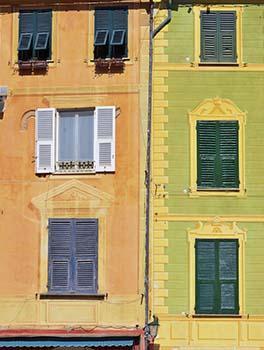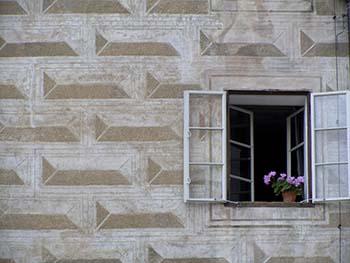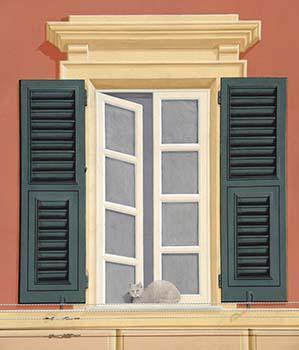Facades with architectural elements painted trompe-l'oeil
Post from EditorialsIn some areas of Italy (eg Liguria) the facades of historic buildings are decorated with a series of architectural elements painted trompe-l'oeil.
Trompe-l'oeil painted facades
 In some areas of Italy such as in Liguria (particularly Genoa), the facades of historic buildings are decorated with a series of architectural elements trompe-l'oeil painted, more or less rich and elaborate on the basis of the building value is therefore foundamental to know the origin and the rules of composition of these kind of decorations, in order to arrange a correct maintenance or even the eventual recovery.
In some areas of Italy such as in Liguria (particularly Genoa), the facades of historic buildings are decorated with a series of architectural elements trompe-l'oeil painted, more or less rich and elaborate on the basis of the building value is therefore foundamental to know the origin and the rules of composition of these kind of decorations, in order to arrange a correct maintenance or even the eventual recovery.
This use is actually very old, because in the Middle Ages (and in particular from the XIV century) became established in fashion to enrich the facades of buildings with geometric patterns (eg inspired by upholstery fabric) or imitation of masonry brick or ashlar of square stones.
During the Renaissance appear instead facades with figurative scenes, heraldic motifs and whole architectural trompe-l'oeil parties: we find wonderful examples in Piazza delle Erbe in Verona and in Spilimbergo in the province of Pordenone.
Anatomy of a trompe-l'oeil painted facade
 The decoration with architectural frames- not necessarily painted but often also in molded plaster or made with noble materials (stone, terracotta) - almost always has the same elements, namely:
The decoration with architectural frames- not necessarily painted but often also in molded plaster or made with noble materials (stone, terracotta) - almost always has the same elements, namely:
- Window Frames: Depending on the case, simple or decorated with straight entablature, lunette or tympanums (triangular and/ or variously shaped and decorated). Generally the window frames also signal the hierarchy of levels: ground floor frames tend to be very simple or even absent, while those on the first floor - usually coinciding with the main floor - are characterized by decorative elements richest and processed . On the upper floors decoration finally becomes less complex: as seen also in the picture of the opening of this article, a typical sequence provides such simple frames on the ground floor, with triangular pediment on the first floor, with entablature on the second and simple again on the third.
- Stringcourses and string-courses: these decorative moldings placed respectively at the floors or at the windows tops: their basic function is to indicate the vertical scan of the plans, thus emphasizing the modularity of the facade. They can appear separately or combined: in many cases we find a decorative motif (though generally limited to the first floor) consisting of stringcourse, string-course and rectangular panels in the parapet of each window.
The preference for the string-course or stringcourse is instead dictated by local building traditions: for example in Liguria seems to prevail the stringcourse, while in Siena or Bologna is almost always prefer the string-course.
- Angular ashlar: The origin of the angular ashlar stems from the need to build the edges of the buildings in stone (the weakest areas of the entire building) with stone ashlars carefully squared. The confirmed models are two: with the ashlars of two lengths (long and short) alternated, more faithful to the true practice of construction, or with the studs of the same length, very similar to a pilaster.
In the grammar of decoration the angular ashlar highlights the vertical limits of the facade, visually separating it from adjacent buildings and attributing a certain modularity to a fifth urban (for example the face of a block).
- Ashlar at ground floor: Often the ground floor is rusticated (as the case of plaster or painted only), with the function of the base, according to a practice rather widespread in the Florentine Renaissance style. Depending on the case the ashlar can be gouged (that is, with the edges of the studs perpendicular to the wire of the facade), rounded (the edges of the indentations form an angle usually of 45° to the edge of the wall), sbaulato (ie with shaped edges quarter-circle) or diamond, with the ashlars in the shape of a pyramid or truncated pyramid. - Imitation stone or faux brick: These decorative motifs used as background generally on the upper floors (when the ground floor is a rusticated plaster shaped or simply painting), if to suggest (in a realistic or conventional) a masonry stone or brick. The materials or types of masonry and the execution techniques are very different, and in this case also are closely dependent on the materials and the local building traditions.
- Imitation stone or faux brick: These decorative motifs used as background generally on the upper floors (when the ground floor is a rusticated plaster shaped or simply painting), if to suggest (in a realistic or conventional) a masonry stone or brick. The materials or types of masonry and the execution techniques are very different, and in this case also are closely dependent on the materials and the local building traditions.
- False doors and windows in many buildings there are whole windows and doors painted in trompe-l'oeil, often very numerous (in a building such as Siena are visible thirteen fake shutters). Again, the possible types are very varied and faithfully reproduce the real fixtures: thus we find doors, windows with railings, windows with leaded glass windows with interior shutters and even fake shutters. In the finest examples - such as the one shown in the photo above - also appear some decorative elements, including for example flower vases, prints and postcards pasted on the windows, curtains and facing animals (eg cats or parrots).
The reasons that led to the realization of trompe-l'oeil of doors and windows are basically two: functional - dabbed ie one or more openings for the needs of various types, such as a different distribution structure of the internal spaces - or aesthetic, that is to assign a symmetry (only apparent) one-sided or embellish a facade secondary otherwise devoid of openings.
79164 REGISTERED USERS










